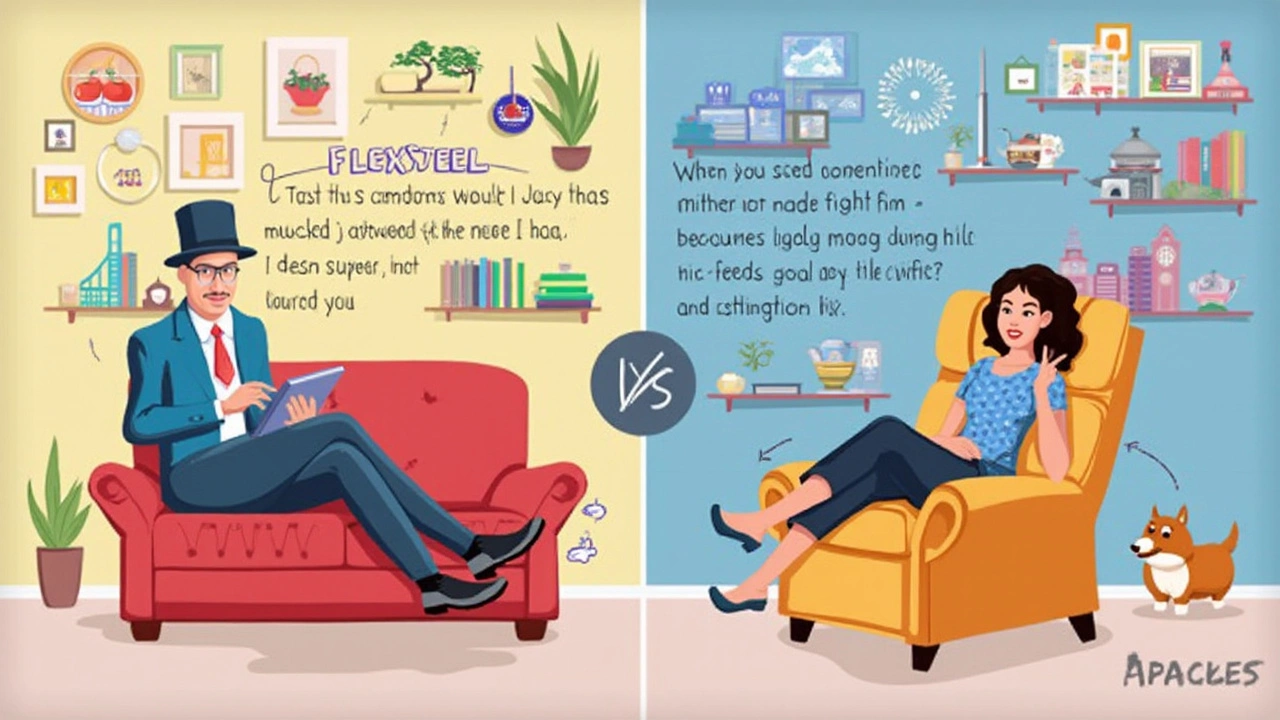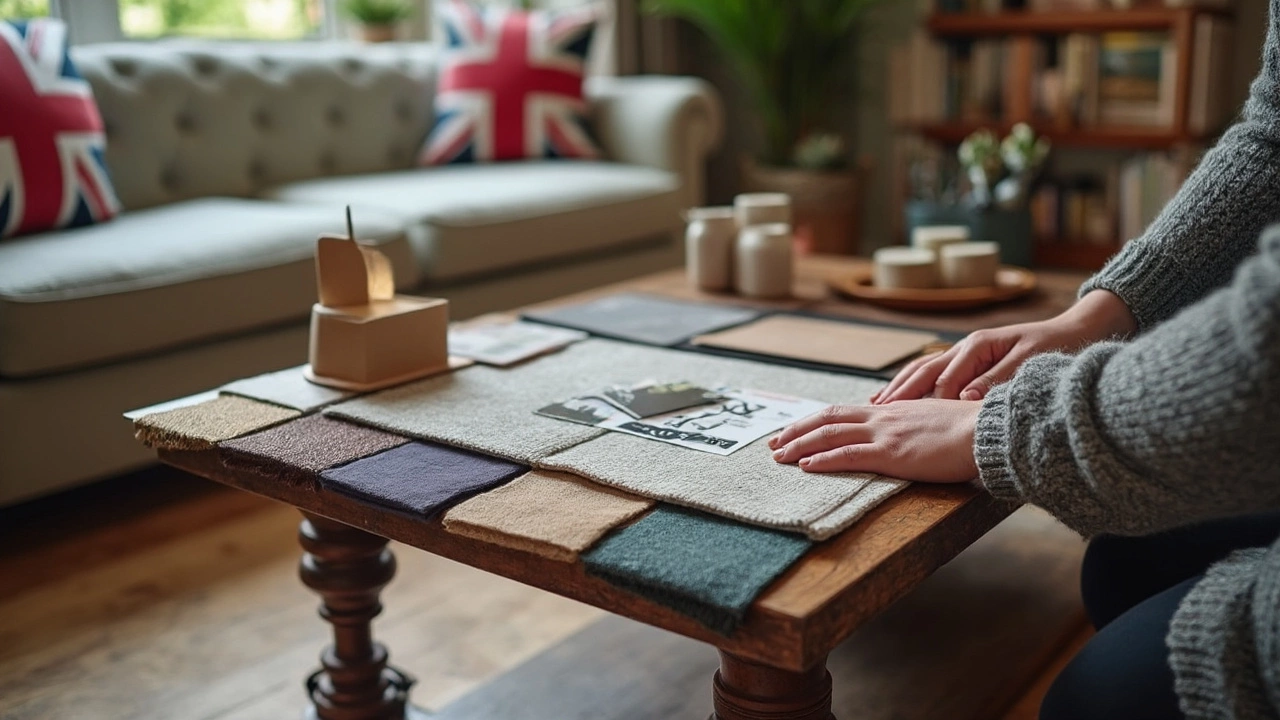
Ever walked into a furniture store and felt paralyzed by leather smells, endless swatches, and prices that could buy you a used car? You’re not alone. Picking between FlexSteel and Lazy Boy can turn a simple living room update into a saga, especially since both brands have been stuck in a rivalry for decades. Furniture salespeople have wild opinions, and online reviews swing from love letters to horror stories. So how do you separate the marketing from the real deal? Get ready for a deep dive: we're going past fancy brochures and glossy catalogs to see which brand actually gives you more bang for your buck.
Here’s a wild stat to kick things off: FlexSteel’s Blue Steel Spring, first patented in 1927, is still a bragging right. This isn’t just marketing fluff—furniture nerds actually hunt for old FlexSteel pieces at estate sales just to see how long those seats last. Lazy Boy, on the flip side, basically invented the modern recliner back in 1928, and some folks still refer to any recliner as a “La-Z-Boy,” even if it’s made by a different brand. Which tells you something about their impact. But do famous histories really translate into better sofas and chairs today?
In 2024, FlexSteel’s focus is still all about durability. Most of their frames are made using hardwoods—think maple, oak, or ash instead of the cheap rubberwood you’ll find in knockoffs—and they still swear by their signature spring system. Their recliners and sofas arrive heavy, sturdy, and, some say, nearly impossible to move once you get them in place. Lazy Boy, on the other hand, has gone big on customization. You get leather, fabric, color, nailhead trim—you name it. They stuff their seat cushions thick and let you pick from loads of upgrades: lumbar supports, motorized recline, USB charging. But Lazy Boy doesn’t use the exact same spring structure as FlexSteel; instead, they rely more on traditional sinuous springs, foam, and engineered wood frames in their entry-level lines.
Want a quick cheat sheet on what sets each apart? Check this table:
| Brand | Signature Feature | Frame Material | Spring System | Made In |
|---|---|---|---|---|
| FlexSteel | Blue Steel Spring, Durability | Hardwood, Plywood | Blue Steel Flat Spring | USA, Mexico, Asia |
| Lazy Boy | Customized Recline, Variety | Engineered Wood, Hardwood | Sinuous Springs/Foam | USA, Mexico |
Pro tip: Don’t skip the label under the sofa—FlexSteel’s usually reads like a technical spec sheet and will mention the Blue Steel Spring. Lazy Boy models, especially from their “made to order” lines, can vary a lot. Always ask if it’s “Signature” or “Premier” construction; some of their basic series use more particleboard and standard foam, which won’t win any awards for lifespan.
Love the idea of buying American? Both have U.S. facilities, but they’re not immune to global supply chains. Some FlexSteel models come from Asian factories, and same goes for a portion of Lazy Boy’s stuff. If "made in the USA" affects your decision, ask specifically for the style’s origin before you swipe the card.

Let’s get blunt: couch comfort isn’t easy to measure. What feels perfect to one person feels like medieval torture to someone else. But step into a FlexSteel showroom, and the first thing you’ll notice is the seat doesn’t sag. There’s no “wobble” when you plop down, and the support stays even after years of messes, movie nights, and dogs thinking they're humans. The Blue Steel Spring, even when hidden under cushion layers, adds bounce and resilience. I’ve talked to people who claim their FlexSteel survived college parties, growing kids, and accidental spills—all with minimal dip or squeak.
Lazy Boy, though, wins the popularity contest by a mile. Ever notice Thanksgiving family photos with that same Lazy Boy recliner in the background? Their legendary recline mechanism still holds up, even if you go wild with feet kicks. The big seller: you can customize back support, pick how much padding you want, and choose from a dizzying selection of arms, legs, and finishes. The result? It’s easy to find "your" chair, not just a model that tries to fit everyone. But some real-world owners admit after five to seven years, the foam in the less expensive Lazy Boy models can start to flatten, especially if someone’s always in their TV zone after work.
Let’s look at durability in day-to-day use. FlexSteel’s frames are built to outlast trends. Their warranty often covers the frame and spring for LIFE (yup, life), which is rare these days. Fabric and leather wear—well, that’s down to you and your pets. Lazy Boy warranties usually cover mechanisms for a few years, and the fancier the model, the better the coverage. Here’s something people miss: the budget Lazy Boy versions at big box stores are different creatures from what you get in a flagship showroom. That’s why those “my recliner only lasted three years” stories pop up online.
A table to give you an idea how long you can expect your sofa to last:
| Brand/Series | Typical Lifespan (years) | Warranty on Frame | Warranty on Mechanism |
|---|---|---|---|
| FlexSteel Main Line | 15-25+ | Lifetime | 5 years |
| Lazy Boy Signature/Premier | 7-15 | Limited Lifetime | 3-5 years |
| Lazy Boy Essentials (Big Box) | 3-7 | 1-3 years | 1-3 years |
A few tips: always test the exact model you’re buying—sit on it, recline it, wiggle the arms. The floor model probably gets more abuse than yours will, so if it holds up in the store, that’s a good sign. If your sofa will take a beating from wild kids or pets, look for stain-resistant fabrics. Lazy Boy’s iClean and FlexSteel’s Revolution line both help with “oops I spilled” moments. Ask about the specific density of seat foam (1.8lbs or higher for serious durability). And yes, pay attention to the fine print on the warranty—it’s worth the boring read.

People wonder, "Why do these sofas cost so much?" Blame it on materials, labor, and the insane customization options. In 2025, FlexSteel has become more style-forward—they offer everything from mid-century modern to traditional looks, and plenty of “small space” options for apartments and condos. Their custom orders let you pick arm shapes, cushion types, even feet styles. But because most FlexSteel pieces are made-to-order, be ready to wait 8-12 weeks (and during supply hiccups, possibly longer). The upside? You’ll likely get a unique piece sized for your room and your style. The downside? Prices start around $1,200 for a basic chair and can topple over $4,000 for a sectional.
Lazy Boy? Totally a choose-your-own-adventure brand. You can go classic and get the Bruce Wayne-style recliner, or lean into modern lines, tufted backs, and modular sections you can rearrange. Their advantage: faster turnaround, and frequent sales. Many stores roll out “Buy More, Save More” deals or interest-free financing. Some mass-market lines can hit as low as $700 for a recliner or $1,500 for a sofa, but as mentioned earlier, entry-level models use less expensive foams and frames. If style matters most, you’ll get wild fabric prints and trims here—think performance velvet, faux leathers, retro florals, and even diamond stitching. They've also embraced tech: built-in USB charging, heated seats, and power headrests that remember your favorite position.
If you demand eco-friendly or hypoallergenic options, both brands now offer “green” fabric choices and formaldehyde-free frames. This is a real win for folks with allergies, asthma, or small, inquisitive kids. Don’t fall for the “all leather is equal” myth—Lazy Boy uses both top grain and split leather, so make sure you clarify before you pay a premium for what could be a lower-cost surface. FlexSteel is usually upfront about this on their spec sheets.
If your budget stretches far, splurge on the top-tier additions: double-stitching, performance foam, unique legs, smart remote control. But if you want to save? Hit floor sample sales or discontinued styles—the price drop can be huge on last season's patterns.
Every living room has its own personality, and sometimes, your back wants things your eyes don't. FlexSteel is the brand for those who don't want to think about replacing a sofa every few years, but want to invest once and forget about it. Lazy Boy? That's your go-to when you want high style, lots of choices, and a chair that has seen more Sunday naps than any other in America. Ultimately, it’s not about which brand is "the best"—it’s about which one fits your budget, your taste, and how you actually use your space. Trust your own test more than any salesman or online rant. Happy lounging.
Write a comment